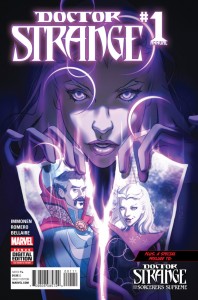 Doctor Strange Annual #1 — Writer: Kathryn Immonen; Art: Leonardo Romero; Colors: Jordie Bellaire
Doctor Strange Annual #1 — Writer: Kathryn Immonen; Art: Leonardo Romero; Colors: Jordie Bellaire
Moon Girl and Devil Dinosaur #11 — Writers: Amy Reeder and Brandon Montclare; Art: Natacha Bustos; Colors: Tamra Bonvillain
Lots and lots of comics this week — almost thirty, and I pruned at least a half-dozen more — so let’s jump in, starting with the two Marvel books that aren’t Civil War II related. Doctor Strange Annual features the return of Clea, the other-dimensional sorceress who’s also Doc’s wife. They’ve had a star-crossed relationship, and are currently separated (she hasn’t been around during the latest incarnation of Doc’s regular series), but, given the magic-destroying events there, she turns up now. It’s a smart look at a complicated relationship, with a funny subplot involving Wong dealing with a magical contractor that ends up intersecting nicely with the main story, and artist Romero does a good job combining the realistic with the more impressionistic occult stuff. There’s also a prelude to the new companion Doc comic, Doctor Strange and the Sorcerers Supreme, by Robbie Thompson and Jonathan Marks 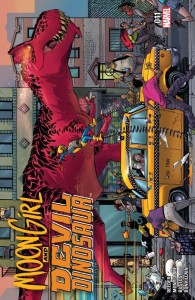 Barravecchia, who has a lush, painted style that’s worth a look (I’d never have thought to see a time when Marvel was publishing two Doctor Strange comics at once, but I hear there’s this movie coming out…). Moon Girl and Devil Dinosaur continues to be a really fun adventure book, both in story and art — look at that cover over to the right there — with its spunky preteen girl, a mix of sophisticated intelligence, ego, and social cluelessness wrapped around a big heart that should be familiar to nerd and Big Bang Theory watchers (she’s like a distaff, pre-adolescent Sheldon), plus her big red carnivore pal, a teddy bear with scales and sharp teeth. Pick this up and see if you don’t like it; it’s Marvel’s best cool-little-kid-with-powers book since the early Power Pack.
Barravecchia, who has a lush, painted style that’s worth a look (I’d never have thought to see a time when Marvel was publishing two Doctor Strange comics at once, but I hear there’s this movie coming out…). Moon Girl and Devil Dinosaur continues to be a really fun adventure book, both in story and art — look at that cover over to the right there — with its spunky preteen girl, a mix of sophisticated intelligence, ego, and social cluelessness wrapped around a big heart that should be familiar to nerd and Big Bang Theory watchers (she’s like a distaff, pre-adolescent Sheldon), plus her big red carnivore pal, a teddy bear with scales and sharp teeth. Pick this up and see if you don’t like it; it’s Marvel’s best cool-little-kid-with-powers book since the early Power Pack.
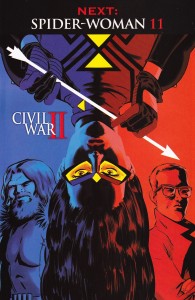 Spider-Woman #11 — Writer: Dennis Hopeless; Art: Veronica Fish; Colors: Rachelle Rosenberg
Spider-Woman #11 — Writer: Dennis Hopeless; Art: Veronica Fish; Colors: Rachelle Rosenberg
Ms. Marvel #11 — Writer: G. Willow Wilson; Art: Takeshi Miyazawa and Adrian Alphona; Colors: Ian Herring
Captain Marvel #9 — Writers: Ruth Fletcher Gage and Christos Gage; Art: Thony Silas; Colors: Matt Wilson
The Ultimates #11 — Writer: Al Ewing; Art: Kenneth Rocafort and Djibril Morissette; Colors: Dan Brown
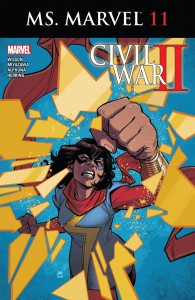 Thunderbolts #5 — Writer: Jim Zub; Art: Jon Malin; Colors: Matt Yackey
Thunderbolts #5 — Writer: Jim Zub; Art: Jon Malin; Colors: Matt Yackey
Practically every Marvel book is now a Civil Wars II tie-in, but these five have the most connection to the event, for various reasons: Spider-Woman has always had the friendship between Jessica Drew and Carol Danvers as a core character concept, but the Hawkeye-kills-Bruce-Banner bit has shattered that, and this issue looks at the ramifications of that death for their relationship, with a  suitably-final conclusion. Ms Marvel does much the same thing, as Kamala’s increasing doubts about the future-profiling system cause her to confront Carol too (in a clever manipulating of Ulysses’s abilities), and give her a similar kiss-off, one which should help lead into Kamala’s new team book, Champions. Captain Marvel itself sees a similar confrontation with Alpha Flight about her policing policies (let’s just say Danvers isn’t having a particularly good week with her allies… two out of these three comics end up with
suitably-final conclusion. Ms Marvel does much the same thing, as Kamala’s increasing doubts about the future-profiling system cause her to confront Carol too (in a clever manipulating of Ulysses’s abilities), and give her a similar kiss-off, one which should help lead into Kamala’s new team book, Champions. Captain Marvel itself sees a similar confrontation with Alpha Flight about her policing policies (let’s just say Danvers isn’t having a particularly good week with her allies… two out of these three comics end up with  her getting punched out by them). All three books have smart, well-intentioned female protagonists, and are drawn in the slightly-manga, bright style that Marvel’s been favoring lately; they’re all good examples of how its mainstream books have begun to represent younger female readers, but are still accessible to everyone else too. Ultimates is more of a brainy sf comic with cosmic-level superhero elements, and it, too, features Carol; only Thanos punches her, though, since most of the book is a big knock-down fight with him as he tries to escape his prison. There’s still discussion of her policies,
her getting punched out by them). All three books have smart, well-intentioned female protagonists, and are drawn in the slightly-manga, bright style that Marvel’s been favoring lately; they’re all good examples of how its mainstream books have begun to represent younger female readers, but are still accessible to everyone else too. Ultimates is more of a brainy sf comic with cosmic-level superhero elements, and it, too, features Carol; only Thanos punches her, though, since most of the book is a big knock-down fight with him as he tries to escape his prison. There’s still discussion of her policies, 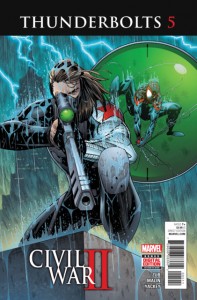 and once again members of her team come out against her, but no one quits or goes crazy, befitting the book’s we’re-all-adults problem-solving model, one of the best things about this volume. Thunderbolts, by contrast, doesn’t have Carol at all; however, it takes place immediately after the end of Civil War II #5, as Bucky Barnes, told of that book’s scene where Ulysses foresaw the Miles Morales Spider-Man killing Captain America, tries to capture him,. That goes about as well as you’d expect; if you’re a fan of either character, or just want to know where Civil War II #6 will be going, you’ll probably enjoy this comic.
and once again members of her team come out against her, but no one quits or goes crazy, befitting the book’s we’re-all-adults problem-solving model, one of the best things about this volume. Thunderbolts, by contrast, doesn’t have Carol at all; however, it takes place immediately after the end of Civil War II #5, as Bucky Barnes, told of that book’s scene where Ulysses foresaw the Miles Morales Spider-Man killing Captain America, tries to capture him,. That goes about as well as you’d expect; if you’re a fan of either character, or just want to know where Civil War II #6 will be going, you’ll probably enjoy this comic.
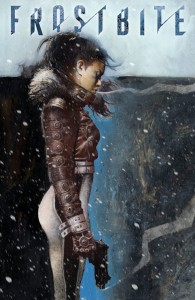 Frostbite #1 — Writer: Joshua Williamson; Art: Jason Shawn Alexander; Colors: Luis NCT
Frostbite #1 — Writer: Joshua Williamson; Art: Jason Shawn Alexander; Colors: Luis NCT
Blue Beetle #1 — Writer: Keith Giffen; Art: Scott Kolins; Colors: Romulo Fajardo Jr.
Batman Beyond: Rebirth #1 (of 1) — Writer: Dan Jurgens; Art: Ryan Sook; Colors: Jeremy Lawson and Tony Avina
Teen Titans: Rebirth #1 (of 1) — Writer: Ben Percy; Art: Jonboy Meyers; Colors: Jim Charalampidis
Four first issues from DC: one from Vertigo, and three from 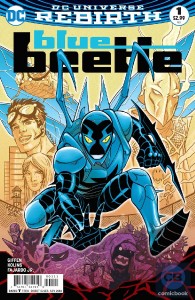 the “Rebirth” relaunches. Frostbite, the Vertigo one, is an sf book by Joshua Williamson (Nailbiter and Birthright, among others), about the Earth fighting both a new Ice Age (caused by experiments with “cold fusion” powered by “climate change,” but that explanation made my head hurt, so let’s skip it) and the infectious disease in the title, one that somehow freezes people from the inside out. Naturally, there’s a cure, but the scientist developing it has to get somewhere else, so it looks like it’s going to be one of those battling-through-an-apocalyptic-wasteland quest comics; Jason Shawn Alexander’s moody, detailed art makes it all look simultaneously bleak and pretty. Blue Beetle starts that character’s new ongoing series, after its “Rebirth” intro
the “Rebirth” relaunches. Frostbite, the Vertigo one, is an sf book by Joshua Williamson (Nailbiter and Birthright, among others), about the Earth fighting both a new Ice Age (caused by experiments with “cold fusion” powered by “climate change,” but that explanation made my head hurt, so let’s skip it) and the infectious disease in the title, one that somehow freezes people from the inside out. Naturally, there’s a cure, but the scientist developing it has to get somewhere else, so it looks like it’s going to be one of those battling-through-an-apocalyptic-wasteland quest comics; Jason Shawn Alexander’s moody, detailed art makes it all look simultaneously bleak and pretty. Blue Beetle starts that character’s new ongoing series, after its “Rebirth” intro 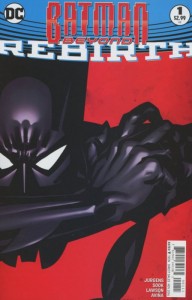 a few weeks ago, with Jaime the focus superhero and being mentored by Ted Kord; it gets by on Keith Giffen’s sophisticated dialogue and Scott Kolins’s light touch and cool page designs. Batman Beyond features the original future Batman, Terry McGinnis, in the lead (he was killed and replaced a year ago, but hey, it’s a reboot), with a recap of how he got the suit and the bat-name, and a plot involving the Jokerz, a street gang who worships the (supposedly) now dead and departed Clown Prince of Crime. Competently done, in both story and art, although I’m not sure it will convince anyone who isn’t already a fan
a few weeks ago, with Jaime the focus superhero and being mentored by Ted Kord; it gets by on Keith Giffen’s sophisticated dialogue and Scott Kolins’s light touch and cool page designs. Batman Beyond features the original future Batman, Terry McGinnis, in the lead (he was killed and replaced a year ago, but hey, it’s a reboot), with a recap of how he got the suit and the bat-name, and a plot involving the Jokerz, a street gang who worships the (supposedly) now dead and departed Clown Prince of Crime. Competently done, in both story and art, although I’m not sure it will convince anyone who isn’t already a fan  of the concept, either from the TV show or from earlier incarnations of the comic, to start following it. Teen Titans sets up the newest version of DC’s perennial kid gang, with Beast Boy, Starfire, Raven and the new-52 Wally West Kid Flash all being brought together by the fifth member, whose identity gets a big reveal at the end but, you now, since he’s also the main character on the cover, isn’t too hard to guess. As an initial one-shot, it’s more about getting the band together and spotlighting each member a bit than generating any actual plot, but the colorful personnel and the intriguing group dynamics should give it some buzz, at least at first.
of the concept, either from the TV show or from earlier incarnations of the comic, to start following it. Teen Titans sets up the newest version of DC’s perennial kid gang, with Beast Boy, Starfire, Raven and the new-52 Wally West Kid Flash all being brought together by the fifth member, whose identity gets a big reveal at the end but, you now, since he’s also the main character on the cover, isn’t too hard to guess. As an initial one-shot, it’s more about getting the band together and spotlighting each member a bit than generating any actual plot, but the colorful personnel and the intriguing group dynamics should give it some buzz, at least at first.
 Titans #3 — Writer: Dan Abnett; Pencils: Brett Booth; Inks: Norm Rapmund; Colors: Andrew Dalhouse
Titans #3 — Writer: Dan Abnett; Pencils: Brett Booth; Inks: Norm Rapmund; Colors: Andrew Dalhouse
Detective Comics #941 — Writer: Steve Orlando with James Tynion IV; Art: Andy Macdonald; Colors: John Rauch
Hellblazer #2 — Writer: Simon Oliver; Art: Moritat; Colors: Andre Szymanowicz and Moritat
Sixpack and Dogwelder #2 (of 6) — Writer: Garth Ennis; Art: Russ Braun; Colors: John Kalisz
 Hal Jordan and the Green Lantern Corps #5 — Writer: Robert Venditti; Art: Ethan van Sciver; Colors: Jason Wright
Hal Jordan and the Green Lantern Corps #5 — Writer: Robert Venditti; Art: Ethan van Sciver; Colors: Jason Wright
Astro City #39 — Writer: Kurt Busiek; Art: Carmen Carnero; Colors: Peter Pantazis
Of the other DC books, Titans continues to be the one most concerned with the underpinnings of the Rebirth/New-52 universe, with longtime, and ultra-powerful, Flash foe 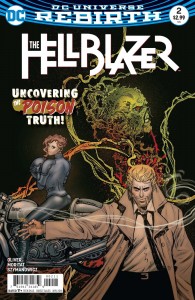 Abra Cadabra taking credit for knocking the pre-new-52 Wally West out of the time stream and altering history — but then name-checking a mysterious “he” behind the scenes and dropping a “Watchman”-like clue about who that might be; lots of action and decent mainstream art by Booth combine with the meta-plot to make it all work. Detective continues the “Night of the Monster Men” bat-crossover, with giant monsters stomping all over Gotham and two of the heroes finding out just a little too much about where they’re
Abra Cadabra taking credit for knocking the pre-new-52 Wally West out of the time stream and altering history — but then name-checking a mysterious “he” behind the scenes and dropping a “Watchman”-like clue about who that might be; lots of action and decent mainstream art by Booth combine with the meta-plot to make it all work. Detective continues the “Night of the Monster Men” bat-crossover, with giant monsters stomping all over Gotham and two of the heroes finding out just a little too much about where they’re 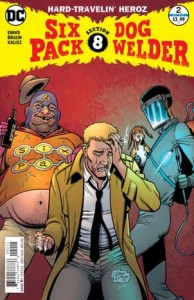 coming from, and how they’re being made. Hellblazer finds John Constantine back in his old stomping grounds and place of power, London, and getting enmeshed in the usual shadowy conspiracies, with the Swamp Think lurking in the background; it’s all pretty standard stuff for him, but the Moritat art, with his creepy guys and gorgeous women, elevates it. Sixpack and Dogwelder features Constantine, too, as Garth Ennis (who scripted his tales quite a few times back in the day) satirizes the current corporate version of
coming from, and how they’re being made. Hellblazer finds John Constantine back in his old stomping grounds and place of power, London, and getting enmeshed in the usual shadowy conspiracies, with the Swamp Think lurking in the background; it’s all pretty standard stuff for him, but the Moritat art, with his creepy guys and gorgeous women, elevates it. Sixpack and Dogwelder features Constantine, too, as Garth Ennis (who scripted his tales quite a few times back in the day) satirizes the current corporate version of 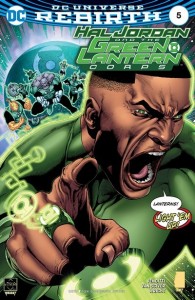 the character, has some fun with the Spectre, and does some icky things with Dogwelder before dropping hints that he’s considerably more important than we might imagine; old Ennis collaborator Russ Braun strikes just the right tone, two-thirds comedy and one part tragedy, for this Hitman spinoff. Hal Jordan and the Green Lantern Corps, one issue away from the end of its first arc, moves all its separated pieces — Jordan, the Sinestro Corps, Guy Gardner, and the lost GLC members — into place for a huge
the character, has some fun with the Spectre, and does some icky things with Dogwelder before dropping hints that he’s considerably more important than we might imagine; old Ennis collaborator Russ Braun strikes just the right tone, two-thirds comedy and one part tragedy, for this Hitman spinoff. Hal Jordan and the Green Lantern Corps, one issue away from the end of its first arc, moves all its separated pieces — Jordan, the Sinestro Corps, Guy Gardner, and the lost GLC members — into place for a huge  confrontation, with old Lantern artist van Sciver bringing his typical dramatic poses and character shots (he draws the best Sinestro, equal parts menace, nobility and fanaticism) and makes everyone look both familiar and suitable heroic. Astro City starts a new multi-parter about Shadow Hill, the title setting’s magic-centric enclave, and its mysterious protector, the Hanged Man, with Busiek’s typically character-rich flourishes, and guest artist Carnero showing a lot of regular artist Brent Anderson’s facility with both faces and eerie heroes; the comic continues to be as dependably entertaining as it’s been for decades.
confrontation, with old Lantern artist van Sciver bringing his typical dramatic poses and character shots (he draws the best Sinestro, equal parts menace, nobility and fanaticism) and makes everyone look both familiar and suitable heroic. Astro City starts a new multi-parter about Shadow Hill, the title setting’s magic-centric enclave, and its mysterious protector, the Hanged Man, with Busiek’s typically character-rich flourishes, and guest artist Carnero showing a lot of regular artist Brent Anderson’s facility with both faces and eerie heroes; the comic continues to be as dependably entertaining as it’s been for decades.
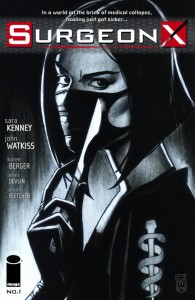 Surgeon X #1 — Writer: Sara Kenney; Art: John Watkiss; Colors: James Devlin
Surgeon X #1 — Writer: Sara Kenney; Art: John Watkiss; Colors: James Devlin
Josie and the Pussycats #1 — Story: Marguerite Bennett and Cameron Deordio; Art: Audrey Mok; Colors: Andre Szymanowicz
Tarzan on the Planet of the Apes #1 — Writers: Tim Seeley and David Walker; Art: Fernando Dagnino; Colors: Sandra Molina
Lots of indy books this week, too, and three debuts: Surgeon X gets some attention because it’s being edited by Karen Berger, who ran DC’s Vertigo imprint for 25 years,  and it does look Vertigo-y, artist John Watkiss having worked on series for that imprint including Sandman, Sandman Mystery Theater, Trigger, Human Target and Deadman. It’s set a couple of decades in the future, where overuse of antibiotics has rendered most medicine ineffective against treatment-resistant diseases, and where the expensive, scarce drugs that actually work are parcelled out to the rich and influential, leaving the masses to fend for themselves; the title character is a woman who’s kind of a guerrilla surgeon, trying to help desperate people with whatever means are at hand, but getting tangled in her own flaws and history while doing it: as I said, a very Vertigo-y setup, and one that fans of that publishing arm in the ’90s and ’00s, and near-future dystopian sf fans generally,
and it does look Vertigo-y, artist John Watkiss having worked on series for that imprint including Sandman, Sandman Mystery Theater, Trigger, Human Target and Deadman. It’s set a couple of decades in the future, where overuse of antibiotics has rendered most medicine ineffective against treatment-resistant diseases, and where the expensive, scarce drugs that actually work are parcelled out to the rich and influential, leaving the masses to fend for themselves; the title character is a woman who’s kind of a guerrilla surgeon, trying to help desperate people with whatever means are at hand, but getting tangled in her own flaws and history while doing it: as I said, a very Vertigo-y setup, and one that fans of that publishing arm in the ’90s and ’00s, and near-future dystopian sf fans generally, 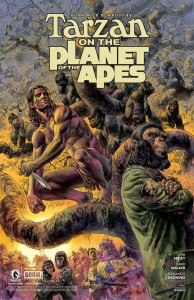 should appreciate. Josie and the Pussycats continues Archie’s reinvention of its line, with the more-realistic-than-Dan-Decarlo, manga/US fusion art you’d expect, and an updated origin story that does its job of being both cute and empowering; this isn’t as cutting-edge as Jem and the Holograms, but manages to tell a decent story in the same general arena anyway. Finally, Tarzan on the Planet of the Apes is one of those books whose title tells you everything you need to know about it, a logical alternate-history mashup of two properties (one old and one really old) that have had some success as comics; the creators don’t do anything super-special with the conceit, but don’t screw it up either, and fans of either franchise should be suitably entertained by it.
should appreciate. Josie and the Pussycats continues Archie’s reinvention of its line, with the more-realistic-than-Dan-Decarlo, manga/US fusion art you’d expect, and an updated origin story that does its job of being both cute and empowering; this isn’t as cutting-edge as Jem and the Holograms, but manages to tell a decent story in the same general arena anyway. Finally, Tarzan on the Planet of the Apes is one of those books whose title tells you everything you need to know about it, a logical alternate-history mashup of two properties (one old and one really old) that have had some success as comics; the creators don’t do anything super-special with the conceit, but don’t screw it up either, and fans of either franchise should be suitably entertained by it.
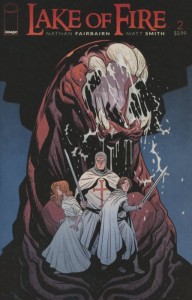 Lake of Fire #2 — Writer/Colors: Nathan Fairbairn; Art: Matt Smith
Lake of Fire #2 — Writer/Colors: Nathan Fairbairn; Art: Matt Smith
Snotgirl #3 — Writer: Bryan Lee O’Malley; Art: Leslie Hung; Colors: Mickey Quinn
The Hunt #3 — Writer/Artist: Colim Lorimer; Colors: Joana LaFuente
Hillbilly #3 — Creator: Eric Powell
 Deadly Class #22 — Writer: Rick Remender; Art: Wes Craig; Colors: Jordan Boyd
Deadly Class #22 — Writer: Rick Remender; Art: Wes Craig; Colors: Jordan Boyd
Saga #38 — Writer: Brian K. Vaughan; Art/Colors: Fiona Staples
Rick and Morty #18 — Writer: Kyle Starks; Art: C. J. Cannon; Colors: Ryan Hill
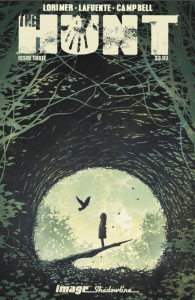 Lumberjanes #30 — Writers: Shannon Waters and Kat Leyh; Art: Carey Pietsch; Colors: Maarta Laiho
Lumberjanes #30 — Writers: Shannon Waters and Kat Leyh; Art: Carey Pietsch; Colors: Maarta Laiho
Island #11 — Creators: Various
All the ongoing indy books: Lake of Fire is set during the Crusades, with a young, naive knight and squire part of a ragtag group of questers who end up facing an infestation  of giant alien bugs; it’s got some effective character bits, moral dilemmas and lots of swordplay and bug guts. Snotgirl is Bryan Lee O’Malley’s tale of a fashionista blogger who’s an online hit but something of a hot mess personally, with insecurities and allergies and a maybe-hallucinatory girlfriend whom she maybe-accidentally-murdered; Leslie Hung’s art is pure manga-fied fun. The Hunt involves deadly fairie creatures in Ireland and the humans who have the second sight to be able to see them, and reach uneasy alliances
of giant alien bugs; it’s got some effective character bits, moral dilemmas and lots of swordplay and bug guts. Snotgirl is Bryan Lee O’Malley’s tale of a fashionista blogger who’s an online hit but something of a hot mess personally, with insecurities and allergies and a maybe-hallucinatory girlfriend whom she maybe-accidentally-murdered; Leslie Hung’s art is pure manga-fied fun. The Hunt involves deadly fairie creatures in Ireland and the humans who have the second sight to be able to see them, and reach uneasy alliances  with the good ones and fight the bad ones; writer/artist Lorimer has managed at least two powerful, eerie-looking one- or two-page splashes in every issue, and this one has them too; they goose the story along and make the book worth buying. Hillbilly is a Southern backwoods horror book by Eric Powell, best known for The Goon, and his very E.C./Jack Davis-like art meshes perfectly with his folk-tale-inspired writing to create a great Hallowe’en treat involving witches, lame dogs, shape-shifting mountain lions,
with the good ones and fight the bad ones; writer/artist Lorimer has managed at least two powerful, eerie-looking one- or two-page splashes in every issue, and this one has them too; they goose the story along and make the book worth buying. Hillbilly is a Southern backwoods horror book by Eric Powell, best known for The Goon, and his very E.C./Jack Davis-like art meshes perfectly with his folk-tale-inspired writing to create a great Hallowe’en treat involving witches, lame dogs, shape-shifting mountain lions,  changelings and other elements; even the title, “The Flesh-Eating Witch Child of Hoodoo Ridge,” drips with dark Gothic exuberance. Deadly Class starts its second season (the first having ended a few months ago, with the truly-unexpected death of a major character), with the returning sophomore kids at its assassin-training school dealing with survivors’ guilt (well, some of them) after their Hunger Games-like first-year graduation exams, and a new crop of freshmen. Betrayal, bullies, in-fighting, tentative relationships, blackmail and blood: it’s just like your high school, only
changelings and other elements; even the title, “The Flesh-Eating Witch Child of Hoodoo Ridge,” drips with dark Gothic exuberance. Deadly Class starts its second season (the first having ended a few months ago, with the truly-unexpected death of a major character), with the returning sophomore kids at its assassin-training school dealing with survivors’ guilt (well, some of them) after their Hunger Games-like first-year graduation exams, and a new crop of freshmen. Betrayal, bullies, in-fighting, tentative relationships, blackmail and blood: it’s just like your high school, only 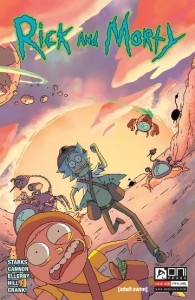 with a much larger cemetery out back. Saga is good as ever, with its own major event involving one of the cast; after 38 issues, each episode is a small chapter in what by now is a big sprawling story, but the little character touches and small human moments give it an intimacy that makes it work even for new readers, and Fiona Staples’s art is always a pleasure. Rick and Morty, itself at 18 issues, only has one plot — Rick callously, between swigs from his flask, almost-sacrifices Morty for his own cynical ends, but either through fate or
with a much larger cemetery out back. Saga is good as ever, with its own major event involving one of the cast; after 38 issues, each episode is a small chapter in what by now is a big sprawling story, but the little character touches and small human moments give it an intimacy that makes it work even for new readers, and Fiona Staples’s art is always a pleasure. Rick and Morty, itself at 18 issues, only has one plot — Rick callously, between swigs from his flask, almost-sacrifices Morty for his own cynical ends, but either through fate or  Rick’s cunning it all works out. Mind you, that’s a durable, entertaining framework (The Fox and the Crow worked it for most of the ’50s and early ’60s), especially in the competent hands of this creative team. Double that praise for the writers of Lumberjanes, Shannon Waters and Kate Leyh, who’ve honed their own mix of adventure, humor, friendship and adolescent life coaching to a fine point over thirty issues, with a number of different artists, and continue to deliver stories with wit, suspense and heart. That’s leaves Island,
Rick’s cunning it all works out. Mind you, that’s a durable, entertaining framework (The Fox and the Crow worked it for most of the ’50s and early ’60s), especially in the competent hands of this creative team. Double that praise for the writers of Lumberjanes, Shannon Waters and Kate Leyh, who’ve honed their own mix of adventure, humor, friendship and adolescent life coaching to a fine point over thirty issues, with a number of different artists, and continue to deliver stories with wit, suspense and heart. That’s leaves Island,  Brandon Graham and Emma Rios’s outsize artbook anthology, with the concluding 30-page chapter of the surreal, cosmic Ancestor, by Matt Sheean and Malachi Ward; the first chapter of Mirenda, a dreamlike, Jeff Jones-ish idyll that’s also 30 pages; the eight-page “The Incident,” an urban horror tale by Robin Bougie and Joseph Bergin III; and “The Pervert,” a slice-of-street-life short that manages to pack a decent punch in just three pages: over 70 pages of gorgeously-produced storytelling for $7.99, explaining why Island is always the bargain of whichever week it comes out in.
Brandon Graham and Emma Rios’s outsize artbook anthology, with the concluding 30-page chapter of the surreal, cosmic Ancestor, by Matt Sheean and Malachi Ward; the first chapter of Mirenda, a dreamlike, Jeff Jones-ish idyll that’s also 30 pages; the eight-page “The Incident,” an urban horror tale by Robin Bougie and Joseph Bergin III; and “The Pervert,” a slice-of-street-life short that manages to pack a decent punch in just three pages: over 70 pages of gorgeously-produced storytelling for $7.99, explaining why Island is always the bargain of whichever week it comes out in.



